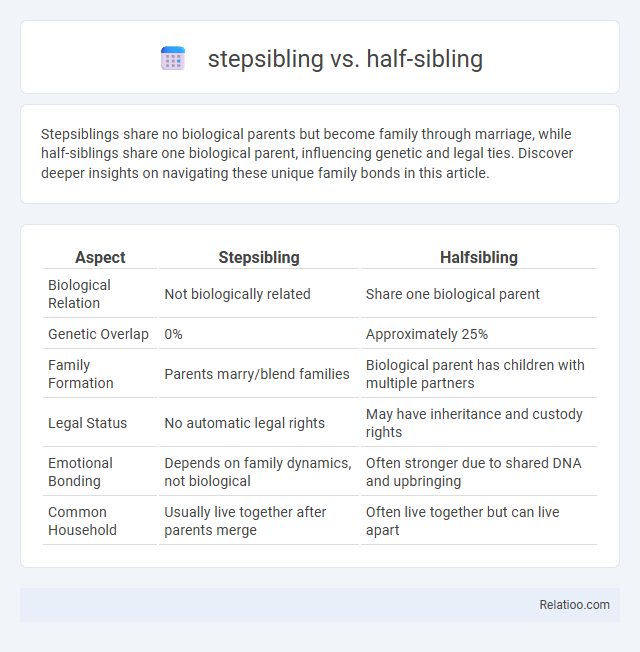Stepsiblings share no biological parents but become family through marriage, while half-siblings share one biological parent, influencing genetic and legal ties. Discover deeper insights on navigating these unique family bonds in this article.
Table of Comparison
| Aspect | Stepsibling | Halfsibling |
|---|---|---|
| Biological Relation | Not biologically related | Share one biological parent |
| Genetic Overlap | 0% | Approximately 25% |
| Family Formation | Parents marry/blend families | Biological parent has children with multiple partners |
| Legal Status | No automatic legal rights | May have inheritance and custody rights |
| Emotional Bonding | Depends on family dynamics, not biological | Often stronger due to shared DNA and upbringing |
| Common Household | Usually live together after parents merge | Often live together but can live apart |
Understanding Stepsiblings and Half Siblings
Stepsiblings are related through marriage with no shared biological parents, while half siblings share one biological parent, either mother or father. Understanding stepsiblings involves recognizing their familial connection stems from blended families, which can influence family dynamics differently than the genetic bond shared by half siblings. Both relationships play significant roles in family structures but vary in terms of genetic relatedness and legal recognition.
Defining Family Relationships: Step vs. Half
Stepsiblings are individuals connected through marriage without sharing biological parents, while half siblings share one biological parent, making your genetic relationship closer to half siblings. Defining family relationships requires understanding these distinctions, as half siblings typically share around 25% of their DNA, whereas stepsiblings share none but often form familial bonds through blended family dynamics. Recognizing these differences clarifies your familial connections and shapes the nature of family interactions.
How Stepsiblings Are Formed
Stepsiblings are formed when two individuals become related through the marriage of their respective parents, without any shared biological connection, creating a legal and social bond rather than a genetic one. Half siblings share one biological parent, either mother or father, resulting in a genetic link that distinguishes them from stepsiblings. Understanding these distinctions clarifies family dynamics and inheritance considerations in blended families.
The Origin of Half Sibling Relationships
Half siblings share one biological parent, originating from relationships where two individuals have a child with the same mother or father but different second parents. Stepsiblings arise from the marriage of two people who each bring children from previous relationships, with no shared genetic connection. The origin of half sibling relationships is rooted in shared genetic lineage, whereas stepsibling relationships are formed through legal or social family structures.
Legal Rights: Stepsibling vs. Half Sibling
Half siblings share at least one biological parent, granting them legal rights related to inheritance, custody, and support, whereas stepsiblings, connected solely through marriage without shared genetics, do not possess automatic legal rights. Legal recognition of half siblings often includes rights to social security benefits, medical decisions, and adoption considerations, unlike stepsiblings who may require legal actions such as adoption or guardianship for similar rights. Family law varies by jurisdiction, impacting the extent of legal rights and responsibilities accorded to both half and stepsiblings.
Emotional Bonds and Family Dynamics
Stepsiblings are connected through marriage without shared genetics, often requiring deliberate effort to build emotional bonds and establish trust within blended families. Half-siblings share one biological parent, typically experiencing deeper, more instinctive attachments that influence family dynamics with a mix of both genetic ties and shared upbringing. Your understanding of these differences can help navigate the unique emotional and relational challenges each sibling type presents in a family's evolving structure.
Inheritance and Family Law Implications
Stepsiblings have no biological relation and generally lack inheritance rights unless specified in a will, while half-siblings share one biological parent and often have legal rights to inherit under intestate succession laws. Family law typically recognizes half-siblings for purposes of inheritance, custody, and support, whereas stepsiblings may require formal adoption or explicit agreements to gain similar legal standing. Legal distinctions between stepsiblings and half-siblings significantly impact property distribution and familial responsibilities after a parent's death.
Navigating Living Arrangements
Navigating living arrangements between stepsiblings and half-siblings requires understanding distinct family dynamics: half-siblings share one biological parent, often resulting in deeper legal and emotional ties, while stepsiblings are connected through marriage without shared genetics. Effective cohabitation strategies include establishing clear boundaries, fostering open communication, and respecting individual privacy to ease the transition in blended homes. Recognizing the varying degrees of biological connection and familial roles helps tailor living arrangements to support positive relationships among stepsiblings and half-siblings.
Social Perception and Cultural Differences
Stepsiblings and half-siblings often face distinct social perceptions influenced by cultural norms and family dynamics. Half-siblings share biological parents, which tends to foster stronger societal recognition and emotional bonds, while stepsiblings are connected solely through marriage, sometimes resulting in varied acceptance levels across cultures. Your experience with these relationships can be shaped by community attitudes and traditions that define family roles and the importance of blood ties versus legal or social connections.
Strengthening Blended Family Connections
Stepsiblings and half siblings both play unique roles in blended families by fostering bonds through shared experiences and family activities, despite differences in biological connection. Stepsiblings share no genetic ties but develop strong emotional relationships through intentional communication, mutual support, and family rituals, which strengthen blended family connections. Half siblings share one biological parent, often benefiting from shared heritage and increased family cohesion, making it essential to nurture both relationships for a harmonious blended family dynamic.

Infographic: stepsibling vs half sibling
 relatioo.com
relatioo.com